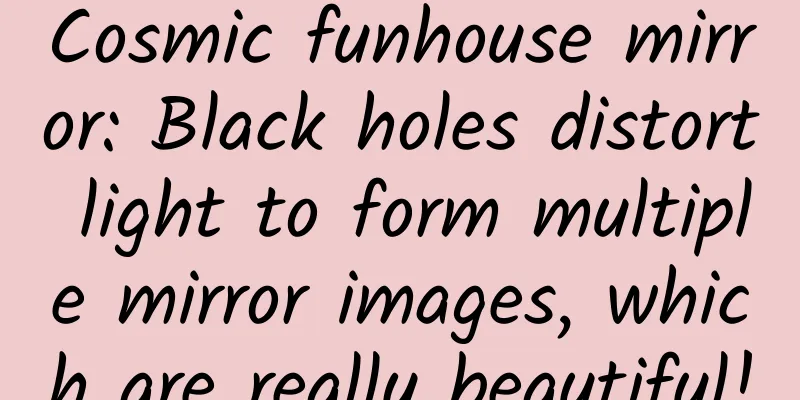Cosmic funhouse mirror: Black holes distort light to form multiple mirror images, which are really beautiful!

|
Black holes distort the universe to form multiple images Illustration of a black hole (Image credit: Mark Glick/Science Image Library) Imagine an entire galaxy reflected in a funny hall of mirrors, where each image of the galaxy becomes increasingly weird and distorted with each repetition. This is what the universe looks like near the event horizon of a black hole, one of the most distorted places in the universe. While physicists previously had some ideas about what these regions look like, a new calculation accurately simulates what can be seen around a black hole, opening up potential new ways to test Einstein's theory of general relativity. Round and round The area near a black hole is really strange. Black holes treat everything equally, regardless of mass. Light is swallowed by the black hole's event horizon, and nothing can escape its immense gravitational pull. But if you put a galaxy behind a black hole and look at it from the other side, you'll see a distorted image of the galaxy. That's because some of the light from the galaxy almost grazes the edge of the black hole but doesn't fall into it. Because of the black hole's extreme gravity, such light is bent in the direction of your line of sight. Strangely, to you as an observer, the galaxy you see appears to be far away from the black hole, rather than directly behind it. The gravity around a black hole is so strong, and space-time so warped, that at a certain distance, light itself can orbit the black hole. Some light from background galaxies can even get trapped, looping around the black hole forever. However, the light needs to be at a precise distance from the black hole to be trapped in orbit. It can also hit the black hole at an angle that causes it to make one (or more) loops before finally escaping. Looking at the edge of a black hole, your eye sees one image of a background galaxy from the deflected light. Then, you see a second image of the Milky Way. The light that successfully made one orbit before escaping is then observed from light that made two orbits, then three, and so on. For decades, physicists have used simple estimates to show that each image is e2π times closer to the edge of a black hole than the last. In this formula, e is the base of natural logarithms, which is approximately equal to 2.7182. Pi is another irrational number, approximately 3.14159, so e2π gives a number very close to 500. This means that each repetition of the same background object is about 500 times closer to the edge of the black hole than the last. This diagram shows how light is mirrored by a background near the edge of a black hole. Light from galaxies in the background surrounds the black hole, creating an endless 'mirror' image of the universe. (Image credit: Peter Lawson) Take some effort While physicists can get this simple result using pen and paper calculations, they're not sure the special factor of 500 is completely accurate if they look closely at the complex curvature of spacetime near a black hole. In a new study, Albert Snepen, a graduate student at the Niels Bohr Institute at the University of Copenhagen in Denmark, used numerical methods to simulate the physics of light orbiting (and escaping) near a black hole. He confirmed that the factor of 500 remained constant in high-precision measurements. His results were published in the journal Scientific Reports. “It’s beautiful to understand why these images repeat themselves in such an elegant way,” Sneppen said in a statement. Snepen found that the factor of 500 only applies to simplified, motionless black holes. Black holes in the real universe rotate, which changes the way light orbits them — which in turn changes the distance at which the image appears. "It turns out that when the black hole is spinning really fast, you no longer have to get 500 times closer to it, but much smaller," Sneppen said. "Each image is now only 50 or 5 times closer, or even down to only twice as close to the edge of the black hole." Because the black hole's rotation distorts the spacetime around it, each successive image of a background object appears flatter. Thus, the most distant images would appear relatively undistorted, while the nearest images might be completely unrecognizable. Enter the amusement park Technically, there are an infinite number of repeating images of background objects, each one closer to the event horizon. In practice, humans will probably never be able to see them, because only a few of the images are resolvable even with the most powerful telescopes. But these few will provide a powerful glimpse into the heart of general relativity, a mathematical theory that describes gravity. In 2019, the Event Horizon Telescope — a disk-shaped network of telescopes spanning the globe — produced the first image of a black hole’s “shadow” cast on the gas and dust surrounding it. That telescope isn’t powerful enough to capture multiple funhouse mirror images of the background object, but future telescopes could. Comparing the mirror images observed by the telescope with the data calculated by Snappen is an unprecedented test of general relativity. For example, if there is a supernova - a very powerful explosion of a dying star - behind the black hole, we will see that supernova explode multiple times. Each image will be delayed by a certain amount of time, depending on how many times it orbits the black hole, allowing researchers to compare their theory with reality. We just have to be willing to stare into the void long enough. BY:Paul Sutter FY: Dong Meihui If there is any infringement of related content, please contact the author to delete it after the work is published. Please obtain authorization for reprinting, and pay attention to maintaining integrity and indicating the source |
<<: How to choose vinegar? Is vinegar really nutritious?
>>: The legendary "Chanhao Bird" is not actually a bird, but a magical animal.
Recommend
Why do cats and tigers look so similar?
Regarding cats and tigers, many people have proba...
Mobike, a detailed explanation of user operation growth strategy based on the WeChat ecosystem!
How does an ordinary user use Mobike ? I thought ...
Nokia 6: A sincere test, but the sentiment has been overdrawn
At CES 2017, HMD, a Finnish manufacturer that has...
What exactly happened when I blacked out after drinking?
© Getty Images Leviathan Press: Almost all of my ...
How to choose soft article promotion channels to maximize the effect?
Introduction: Choosing a soft-article promotion c...
iOS 15 new features fully exposed: "Find" will bring 3 major upgrades, Apple fans: It's amazing
Not only that, after upgrading to iOS15, Apple wi...
How to seize the Spring Festival marketing opportunities when people stay at home to celebrate the New Year?
The Spring Festival is approaching, and Spring Fe...
Foreign media evaluates the current status of China's e-commerce logistics: profound changes are about to hit
Foreign media reported that according to statisti...
Short video promotion and operation: Who has better ability to bring goods?
Why do the giants all want to make short videos? ...
Suggestions for marketing conference activities!
Conference activity plan suggestions For specific...
The secret behind Beijing's "snowfall" in April is...
Auditing expert: Yang Yanhui, Senior Garden Engin...
Sogou advertising efficient delivery case study!
01. Insights into the thermal insulation material...
Can nubia Z9, a milestone in the borderless era, become a new benchmark for domestic mobile phones?
I don’t know since when, domestic smartphones hav...
Why can't your interactive solution pass? Experts from big companies teach you these four methods!
This week, we specially invited Yi Yi, a former s...
Broken bones from a sneeze? These signs in your body indicate your bones are becoming brittle!
In the orthopedic clinic, we often see patients w...









